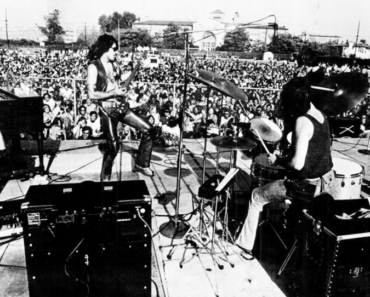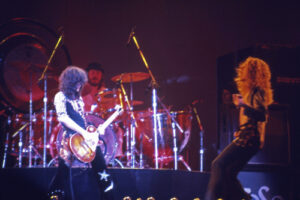
Feature Photo: Lynn Goldsmith; Distributed by Elektra Records, Public domain, via Wikimedia Commons
I will never forget the first time I heard the song “Just What I Needed.” It was on the radio in the late seventies. It was a sound that I had never really heard before. That was the wonderful thing about growing up in the ’70s: every six months, there seemed to be a new band that arrived on the scene with a unique sound that would just spin your head and blow your mind as you raced to the record store to but the debut album. It happened with bands like Foreigner, Boston, Heart, and so many more. One of those grand moments was, of course, fueled by a band we all came to love called The Cars
. Formed in 1976 by Ric Ocasek and Benjamin Orr, the group solidified its lineup with guitarist Elliot Easton, keyboardist Greg Hawkes, and drummer David Robinson. Prior to their breakthrough, Ocasek and Orr had played together in several earlier bands, including Milkwood and Richard and the Rabbits, working the Northeast club circuit and developing the partnership that would anchor The Cars’ signature sound.
The band’s self-titled debut album, released in 1978, set an immediate standard. The Cars delivered a string of now-classic singles including “Just What I Needed,” “My Best Friend’s Girl,” and “Good Times Roll,” all of which garnered substantial radio play and showcased the group’s talent for hook-laden songwriting, inventive arrangements, and cutting-edge production. Roy Thomas Baker, known for his work with Queen, produced the album, helping to forge a slick, modern sound that fit the era’s embrace of synthesizers and electronic elements. The debut album became a massive commercial success, eventually earning multi-platinum certification and spending over two and a half years on the Billboard charts.
Building on that momentum, The Cars released Candy-O in 1979, further expanding their sonic palette and confirming their place among American rock’s elite. The album featured standout tracks like “Let’s Go” and “It’s All I Can Do.” The distinctive cover art, painted by pin-up artist Alberto Vargas, contributed to the band’s growing visual identity. Candy-O peaked at number three on the Billboard 200, and solidified The Cars as consistent hitmakers, able to merge artistic ambition with pop accessibility.
1980 saw the release of Panorama, a more experimental and moody effort, which included the single “Touch and Go.” While it did not match the commercial highs of its predecessors, the album’s willingness to push boundaries highlighted the band’s creative restlessness. They rebounded with Shake It Up in 1981, a record that returned the group to the charts with its infectious title track and “Since You’re Gone.” Shake It Up became their first album to break the top ten on the Billboard 200, reaffirming their popularity with both rock and mainstream audiences.
The Cars reached their commercial and artistic zenith with the 1984 release of Heartbeat City. Produced by Robert John “Mutt” Lange, the album delivered a sequence of smash hits: “Drive,” “You Might Think,” “Magic,” and “Hello Again.” “Drive,” featuring lead vocals from Benjamin Orr, became the band’s highest-charting single in the United States, peaking at number three on the Billboard Hot 100. The innovative video for “You Might Think” won the inaugural MTV Video Music Award for Video of the Year, a testament to the band’s knack for visual as well as sonic innovation. Heartbeat City propelled The Cars to a new level of stardom, with multi-platinum sales and international acclaim.
By the mid-1980s, the members began exploring projects outside the band. Ric Ocasek and Benjamin Orr both released solo albums, while Greg Hawkes, Elliot Easton, and David Robinson participated in various musical collaborations and production work. Despite this, The Cars remained a dominant presence on radio and MTV, thanks to their forward-thinking music videos and catchy, keyboard-driven rock.
In 1987, The Cars released Door to Door, which included the top-twenty single “You Are the Girl.” While the album was less successful commercially and critically than their earlier work, it marked the last collaboration of the original lineup. Shortly after its release, the band announced their breakup, each member moving on to pursue individual interests.
During their hiatus, The Cars’ influence became even more apparent. Their catalog of hits remained staples of classic rock radio, and their sound shaped the direction of countless alternative, pop, and indie acts in the decades that followed. The enduring appeal of their songs ensured their continued relevance, with “Just What I Needed,” “Drive,” and “Good Times Roll” regularly featured in film, television, and advertising.
The loss of Benjamin Orr to pancreatic cancer in 2000 was deeply felt by fans and bandmates alike. His contributions as a vocalist and bassist were vital to the band’s success, and his performance on tracks like “Drive” remains among the most memorable in rock history. The Cars briefly reunited in 2010, with the surviving original members—Ocasek, Easton, Hawkes, and Robinson—recording the album Move Like This, released in 2011. Although Orr’s absence was notable, the album received positive reviews and demonstrated the band’s enduring chemistry and creative vitality.
Throughout their career, The Cars released seven studio albums: The Cars (1978), Candy-O (1979), Panorama (1980), Shake It Up (1981), Heartbeat City (1984), Door to Door (1987), and Move Like This (2011). Their run of hit singles includes “Just What I Needed,” “My Best Friend’s Girl,” “Let’s Go,” “Shake It Up,” “You Might Think,” “Magic,” and “Drive.” The band earned numerous accolades, including induction into the Rock and Roll Hall of Fame in 2018, and multiple American Music Award nominations. Their groundbreaking music videos received early recognition at the MTV Video Music Awards, cementing their legacy as pioneers in merging music and visual storytelling.
The Cars’ unique combination of songwriting prowess, sonic innovation, and visual flair has made them enduring favorites among fans and critics alike. Their music continues to inspire new generations, and their albums are widely regarded as touchstones of late 20th-century rock. The band’s willingness to experiment—while still delivering undeniable hooks—set them apart in an era crowded with talent.
Ric Ocasek, who passed away in 2019, remained an influential presence in music, not only through The Cars’ legacy but also as a solo artist and producer, working with acts such as Weezer and No Doubt. The rest of the band have also contributed significantly to the music world, through session work, solo projects, and mentoring younger artists.
The Cars’ story is one of innovation, resilience, and an unerring sense for melody and style. Their catalog stands as a testament to their creative ambition, technical skill, and knack for connecting with listeners. Decades after their debut, their influence can still be heard across a broad spectrum of popular music—a fitting legacy for a band that helped define the sound and style of a generation.
Complete List Of The Cars Songs From A to Z
- A Dream Away – Shake It Up – 1981
- All Mixed Up – The Cars – 1978
- Baby I Refuse – Heartbeat City – 1984
- Be My Baby – Panorama – 1980
- Blue Tip – Move Like This – 2011
- Breakaway – Heartbeat City – 1984
- Bye Bye Love – The Cars – 1978
- Candy-O – Candy-O – 1979
- Coming Up You – Door to Door – 1987
- Coming Up You Again – Shake It Up – 1981
- Cruiser – Shake It Up – 1981
- Dangerous Type – Candy-O – 1979
- Don’t Cha Stop – The Cars – 1978
- Don’t Go to Pieces – Panorama – 1980
- Don’t Tell Me No – Panorama – 1980
- Door to Door – Door to Door – 1987
- Double Life – Candy-O – 1979
- Double Trouble – Door to Door – 1987
- Down Boys – Panorama – 1980
- Drag On Forever – Move Like This – 2011
- Drive – Heartbeat City – 1984
- Everything You Say – Door to Door – 1987
- Fine Line – Door to Door – 1987
- Free – Move Like This – 2011
- Getting Through – Panorama – 1980
- Gimme Some Slack – Panorama – 1980
- Go Away – Door to Door – 1987
- Good Times Roll – The Cars – 1978
- Got a Lot on My Head – Candy-O – 1979
- Heartbeat City – Heartbeat City – 1984
- Hello Again – Heartbeat City – 1984
- Hits Me – Move Like This – 2011
- Hotel Queenie – The Cars – 1978
- I Refuse – Heartbeat City – 1984
- I’m in Touch with Your World – The Cars – 1978
- I’m Not the One – Shake It Up – 1981
- It’s All I Can Do – Candy-O – 1979
- It’s Not the Night – Heartbeat City – 1984
- It’s Only – Move Like This – 2011
- Jacki – Heartbeat City – 1984
- Just What I Needed – The Cars – 1978
- Keep On Knocking – Move Like This – 2011
- Leave or Stay – Door to Door – 1987
- Let’s Go – Candy-O – 1979
- Looking for Love – Heartbeat City – 1984
- Lust for Kicks – Candy-O – 1979
- Magic – Heartbeat City – 1984
- Maybe Baby – Shake It Up – 1981
- Midnight Dancer – Shake It Up – 1981
- Misfit Kid – Panorama – 1980
- Moving in Stereo – The Cars – 1978
- My Best Friend’s Girl – The Cars – 1978
- Night Spots – Candy-O – 1979
- One by One – Move Like This – 2011
- One More Time – Heartbeat City – 1984
- Panorama – Panorama – 1980
- Rocket USA – Move Like This – 2011
- Running to You – Panorama – 1980
- Sad Song – Move Like This – 2011
- Shake It Up – Shake It Up – 1981
- Shooting for You – Panorama – 1980
- Shoo Be Doo – Candy-O – 1979
- Since I Held You – Candy-O – 1979
- Since You’re Gone – Shake It Up – 1981
- Soon – Move Like This – 2011
- Stranger Eyes – Heartbeat City – 1984
- Strap Me In – Door to Door – 1987
- Take Another Look – Move Like This – 2011
- Take It On the Run – Shake It Up – 1981
- Take What You Want – The Cars – 1978
- Ta Ta Wayo Wayo – Door to Door – 1987
- That’s It – Candy-O – 1979
- The Edge – Panorama – 1980
- The Little Black Egg – Shake It Up – 1981
- They Won’t See You – The Cars – 1978
- Think It Over – Shake It Up – 1981
- This Could Be Love – Shake It Up – 1981
- Tonight She Comes – Heartbeat City – 1984
- Too Late – Move Like This – 2011
- Touch and Go – Panorama – 1980
- Up and Down – Panorama – 1980
- Victim of Love – Shake It Up – 1981
- Wake Me Up – The Cars – 1978
- Why Can’t I Have You – Heartbeat City – 1984
- Wound Up on You – Door to Door – 1987
- You Are the Girl – Door to Door – 1987
- You Can’t Hold On Too Long – Candy-O – 1979
- You Just Can’t Push Me – The Cars – 1978
- You Might Think – Heartbeat City – 1984
- You Wear Those Eyes – Panorama – 1980
- You’re All I’ve Got Tonight – The Cars – 1978
Albums
The Cars (1978): 14 songs
Candy-O (1979): 12 songs
Panorama (1980): 14 songs
Shake It Up (1981): 13 songs
Heartbeat City (1984): 14 songs
Door to Door (1987): 12 songs
Move Like This (2011): 13 songs
Check out our fantastic and entertaining Cars articles, detailing in-depth the band’s albums, songs, band members, and more…all on ClassicRockHistory.com
The Cars’ Best Song On Each Of Their Studio Albums
Complete List Of The Cars Band Members
10 Biggest Hits By The Cars
The Pop Rock Mastery of the Cars’ Debut Album
The Cars Albums Ranked
11 Essential Songs From The Cars
Read More: Artists’ Interviews Directory At ClassicRockHistory.com
Read More: Classic Rock Bands List And Directory










































